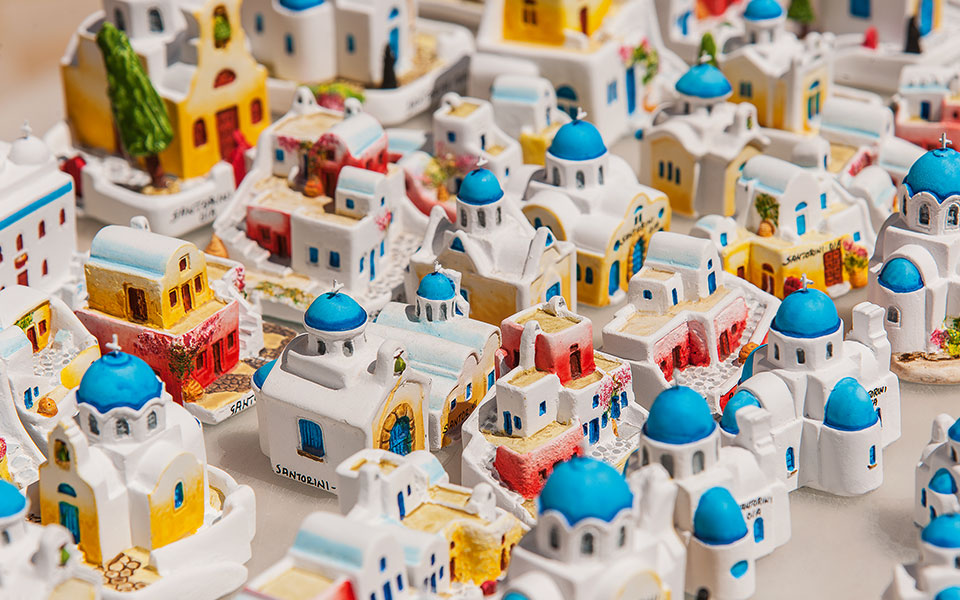I. Construction
The Thera Municipal Authority is regularly flooded with applications for permits for building construction, building expansion or modification of their use. This is the grim reality on one of the world’s most popular islands. As more and more concrete is poured, traditional settlements find themselves under siege. In some villages, in fact, new constructions account for up to 90% of all buildings.
From 2004 to 2015, the number of hotel beds grew by 50% while, in the last eight years, the island’s population has shot up from 15,000 to 25,000. Just last February, CNN listed Santorini among 12 destinations that travelers might want to avoid. This is, without a doubt, an island under pressure.
Mayor Nikos Zorzos feels this pressure all too keenly. Last December, at the annual “Santorini in Athens” meeting hosted by the Acropolis Museum, he issued yet another warning about the dangers of overdevelopment and asked for limits to be set on construction before the island loses all of its unique charms. Some well-intentioned entrepreneurs on Santorini agree with the mayor privately, but urge him not to rock the boat. Others accuse him of sabotaging tourism. Yet Zorzos insists that these problems should not be swept under the carpet – even though he knows that he’s facing an uphill battle.
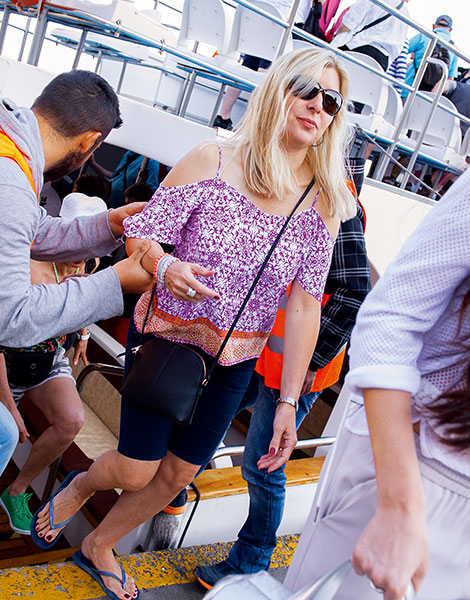
© Vangelis Zavos
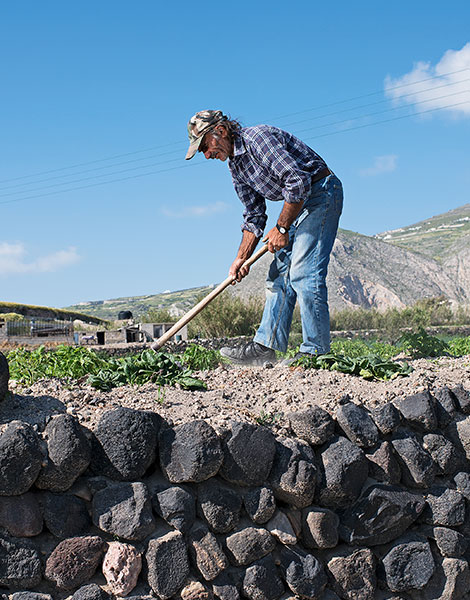
© Vangelis Zavos
II. CRUISE SHIPS
One fight which Santorini’s mayor already seems to be winning after years of effort is for the gradual implementation of a berth allocation system, to put a cap of 8,000 on the number of cruise visitors the island receives per day. For years, maximum daily numbers reached as high as 20,000, causing incredible congestion and hassle for visitors and residents alike. This year, that problem is expected to occur on just five or six specific dates. One of these is June 13, when the port of Athinios is bracing to receive five cruise ships (operated by Royal Caribbean, Celebrity, MSC, Costa and Norwegian), each carrying between 2,000 and 3,500 passengers.
Santorini has a love-hate relationship with cruise tourism. Artist Christoforos Asimis remembers how back in the 1950s, the island’s children would present arriving cruise passengers with flowers and bid them happy sailing by lighting small lanterns along the steps from Fira to Yialos harbor, offering them a beautiful farewell spectacle.
An increase in arrivals in the early ‘70s, mainly of Americans intrigued by news of the work being done at the Akrotiri excavation, proved to be the spark for the tourism boom. “There was only a handful of souvenir shops, and they brought their wares in from Monastiraki in Athens and sold them at insane prices,” Asimis says. “There were two Cretan families that sold handmade rugs and throws. The post office in Fira was piled high with them. There were packages of them everywhere, waiting to be sent all over the world. These small merchants eventually invested their profits in the hotel business.” It was an era of opportunity for everyone.
“In 1973, just after my military service, Eleni [his wife, a sculptor] and I opened a small gallery to show our work. We paid 1,000 drachmas rent a year. One of the cruise ship guides took a liking to us and started bringing us small groups on the weekends. I spent the week doing watercolors and sold out everything I’d done every Saturday. We must have made around 83,000 drachmas in that year alone. It allowed us to start our home.”
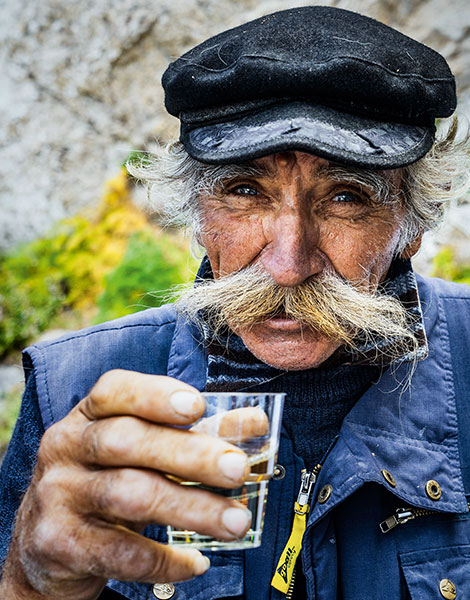
© Perikles Merakos
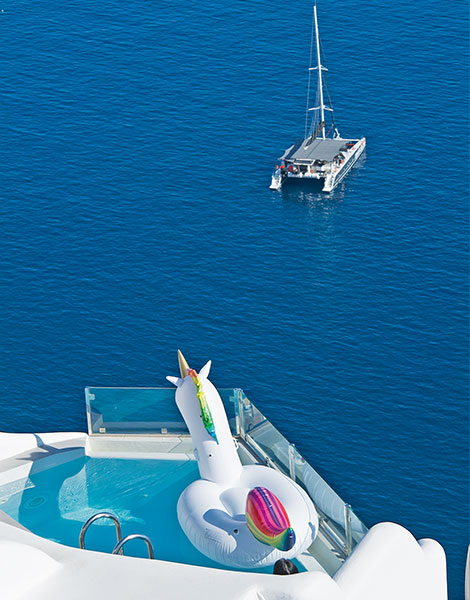
© Vangelis Zavos
Times have changed. Cruise ship tourism has become a mass market and the vessels just keep getting bigger. They can no longer tie up at the much-beleaguered port of Athinios (an environmental impact study was recently approved for its long-anticipated reconstruction) nor, of course, at Yialos, which serves Fira.
So what happens? A company operating a fleet of sea shuttles, each carrying 120-150 passengers, takes organized groups from the cruise ships to the port of Athinios, where they board buses for half-day and full-day tours. Another company takes individual tourists to Yialos, where they can arrange for their own tour and head up to the main town by cable car or donkey.
At the KTEL bus station at 07:00 sharp, we met with Yiannis Marinos from TravelWay, a tour organizer who specializes in cruise ship passengers, and boarded one of the 120 (!) large touring buses that currently serve the island, together with about 15 guides (mostly expats living on Santorini). Our bus headed to Athinios, where passengers from the MSC Musica, a cruise ship with a capacity of 2,550, were expected. On the way, we were briefed on the itinerary, which had been planned down to the minute: Akrotiri, Oia, Santo Wines, Fira and back to Athinios.
The sea was calm, the port workers were on hand to help the passengers (many of whom were elderly) disembark from the shuttles, and the process of getting around 800 people to shore and into their designated buses went smoothly. This isn’t always the case. When a number of cruise ships and passenger ferries arrive at the same time, or when choppy seas make disembarkation trickier, traffic congestion at the port and huge queues at the Yialos cable car make for a rough start to the Santorini experience.
The question is: at the end of the day, what does Santorini get from all this? The lion’s share of the profits stays with the ships. According to data from the Bank of Greece, in 2016 Santorini’s revenue from approximately 800,000 cruise ship visitors was just €43.7 million pre-tax – about €50 per person.

© Dimitris Vlaikos
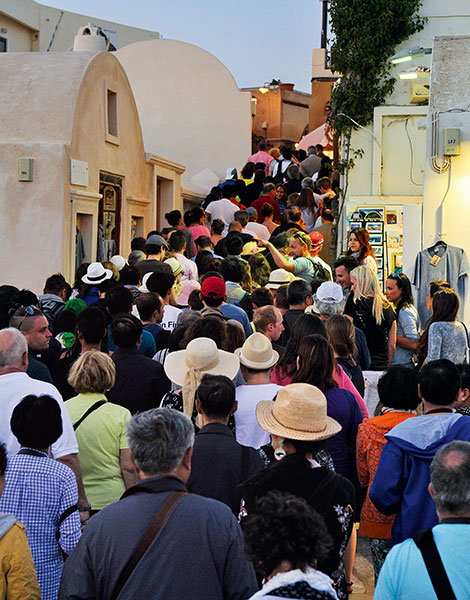
© Vangelis Zavos
III. JACUZZIS AND POOLS
Revenues are staggeringly higher from the luxury hospitality sector, which sees cruise ship tourism as damaging to the island. But luxury accommodation on Santorini has come to mean private swimming pools and Jacuzzis that allow visitors to enjoy a soak while gazing out at the caldera. “We are 99 percent to blame for this,” admits Manolis Darzentas, a former ship engineer who opened Santorini’s leading pool construction firm some 30 years ago. His company is renowned for making sure that even the smallest pools (1.20×1.60m) they install are built-in, giving them a far classier look than the standard, above-ground plastic models. He can’t remember how many pools and Jacuzzis he’s installed to date: “If 500 to 600 are put in every year on the island, then we’re responsible for 300 of them.”
The technical challenges are daunting, there’s no margin for error, time limits are always tight and some clients have tastes that can only be described as bizarre. On the other hand, “you can’t have a luxury hotel in Santorini without pools,” says Darzentas. “Access to the beaches isn’t easy and any visitor’s dream is to stay in a suite where they can soak in a private pool or Jacuzzi while enjoying the view.” Tour operators demand this amenity from hoteliers, and offering it can push up room rates by four or fives times.
Even though he is one of the links in the chain of building activity here, Darzentas believes that, for Santorini’s survival, construction needs to be strictly regulated. “It needs to be fair, though. When everyone has done their own thing, you can’t just punish the last guy to come along. If one guy wants to paint his property blue, the other green and the other red so they stand out, you need to stop that,” he says. “I believe that, overall, Santorini is inexpensive for what it is. Do you know that we have units that go for as much as €20,000 a day, with private chefs and butlers? And there are people who are happy to pay that and more who would like to. But we need to upgrade our infrastructure – the airport, ports and roads; our public face, in other words – if we want to demand that kind of money. We are the hottest thing around right now, but we have to invest.”
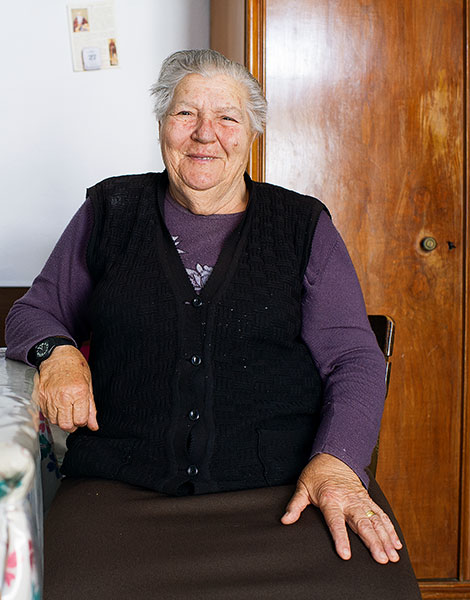
© Vangelis Zavos
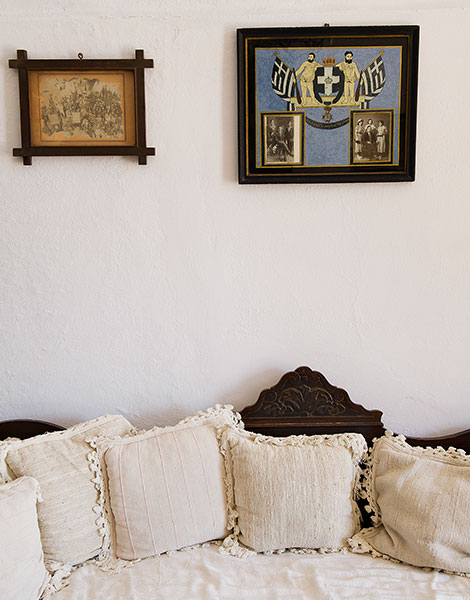
© Vangelis Zavos
IV. KATINA: WITNESS TO A BYGONE ERA
“Do you like how Santorini’s become?” I ask Katina, a resident of Megalochori who was kind enough to open her home to us one afternoon, showing us into the small living room where she spends much of her day in the company of old photographs and her TV.
“No, I don’t,” she says. “We used to go to Fira by donkey, but now you can’t go anywhere unless you’ve got a car. I know families where the father, the mother and the son each have their own car.”
Katina has four brothers and has worked since she was 10 years old. “We had mules, cows, rabbits and pigs. It was my job to take care of them. I also worked out in the field, weeding and thinning out the tomato plants. I got married and there was no better man than my husband, but he was old; 54 to my 27. He died within 10 years and left me with three children.
I did everything to provide for them. I sold car parts, worked at the Boutaris Winery, cleaned homes and worked in bakeries. By the grace of God, I built two homes for my children.” Katina represents a part of Santorini that is at risk of being lost forever. Visitors to the island today may find it hard to believe that there are families who once had their main residence in Fira and a summer home in Exo Gonia or Messaria, and that they traveled between them by donkey. I think back on something amazing that Christoforos Asimis had said, and it seems equally impossible: “When we were kids, we used to look down at the sea from the cliffs, and for us it was as though the whole world was like that. I was amazed when I went to the beach for the first time at the age of six; I was looking at the sparkling surface of the sea, and it was as if all the world’s silver was spread out before me.”
V. THE CHURCH FESTIVAL
We get a tiny taste of what it was like to get around Santorini back in the day on our way up a rugged path from Pyrgos to the small church of Aghios Georgios Katefios, which was built in the 18th century in honor of Saint George and nicknamed either after the Greek word “katafigio” (refuge), or “katifeia” (which means melancholy), as it receives little sun. There are myriad legends about this chapel: one concerns a princess who found shelter here after being banished by her father, who disapproved of her beau; another is about a captain whose prayers for calm seas during a storm were answered, and so on. Like many churches in Santorini, this one is owned by a family; it is their duty to host the annual celebration of the saint. Martha Katavari-Koutsogiannopoulou, a pensioner who lives in Pyrgos, keeps the tradition alive. As the feast day of Aghios Georgios approaches, she struggles up the rocky path again and again, carrying everything she needs to get the church ready. On the big day, young and old come together in a festivity that keeps a part of the old way of life alive. They eat fried fish, chick-pea and tomato casserole with sausages, slices of local graviera cheese and hunks of sourdough bread. The wine flows freely. They share news and jokes, they dance and sing – as they have always done. But will the next generation put in the same effort?
VI. THE FOLKLORE MUSEUM
Architect Jenny Kyritsi runs the Manolis Lignos Folklore Museum in Kontochori in Fira. A lawyer and former publisher of the now-defunct local newspaper Therian News, Lignos turned his mid-19th-century ancestral home into a veritable “time machine.” The exhibits here capture perfectly how the people of Santorini lived some 150 years ago, and Jenny is always on hand to tell the story of every object. Anyone who truly loves Santorini and is interested in knowing more than just what the postcards show should make a stop here. But how many do?
Santorini is indeed one of the world’s most beautiful islands. But there’s so much more to it than meets the eye.

